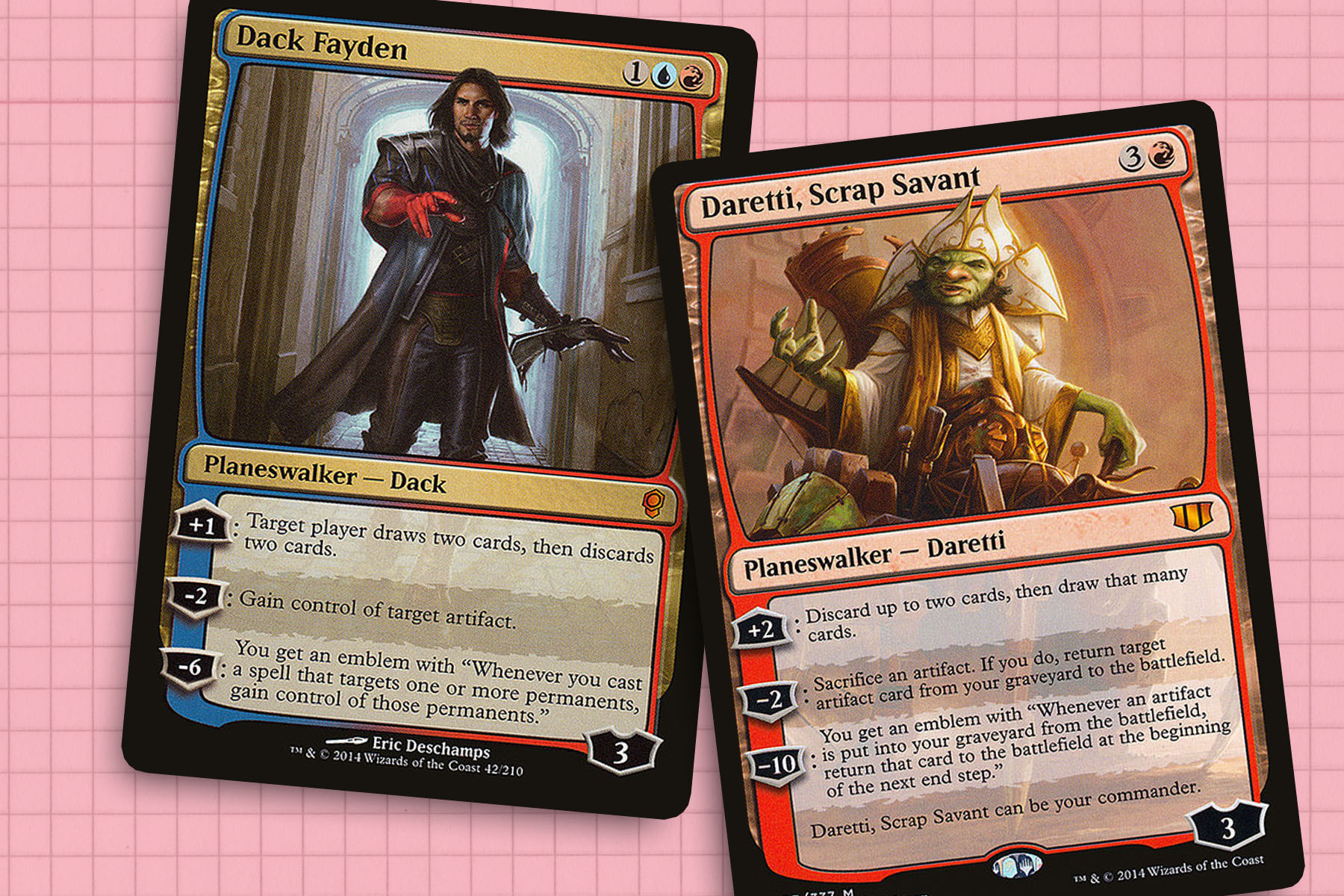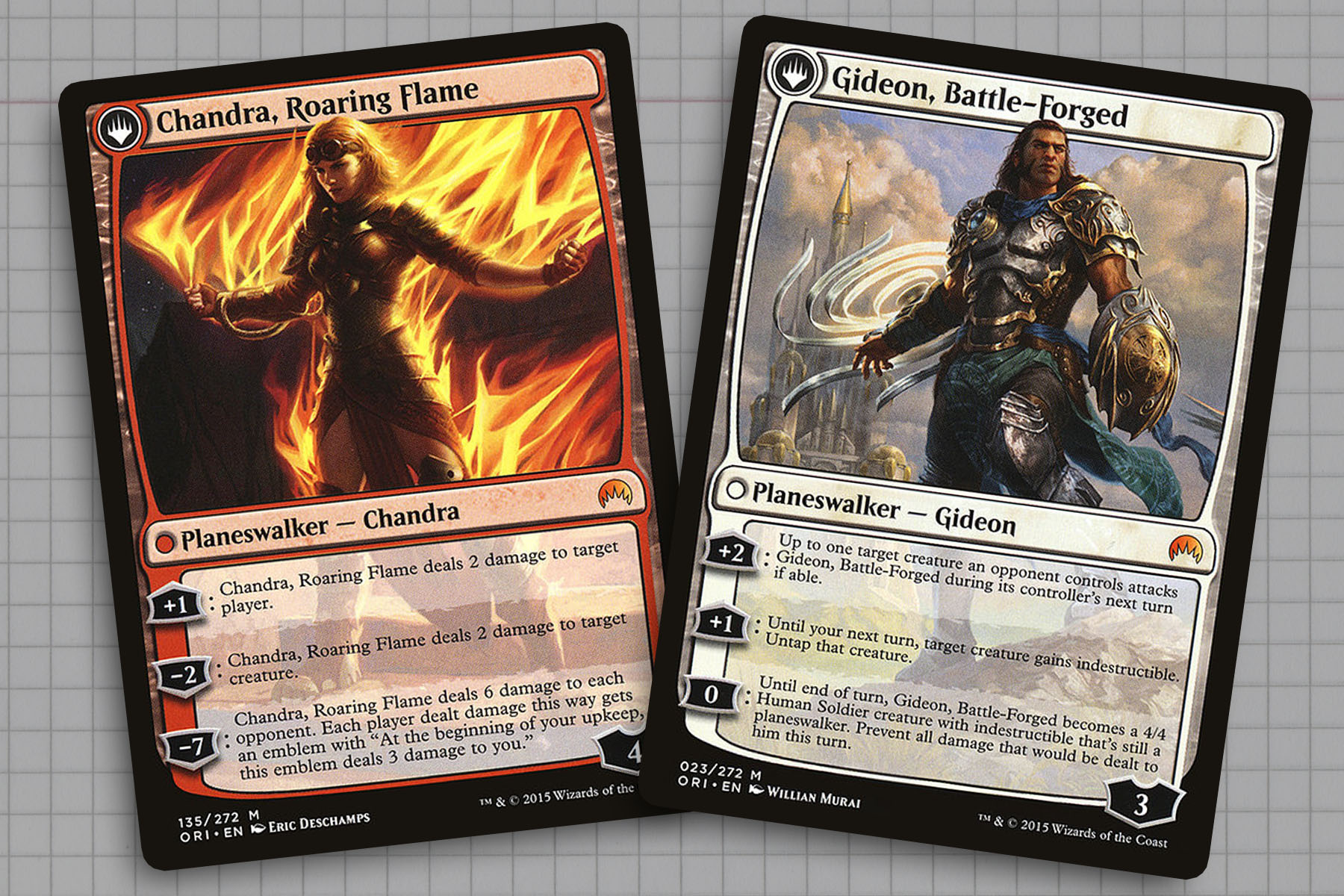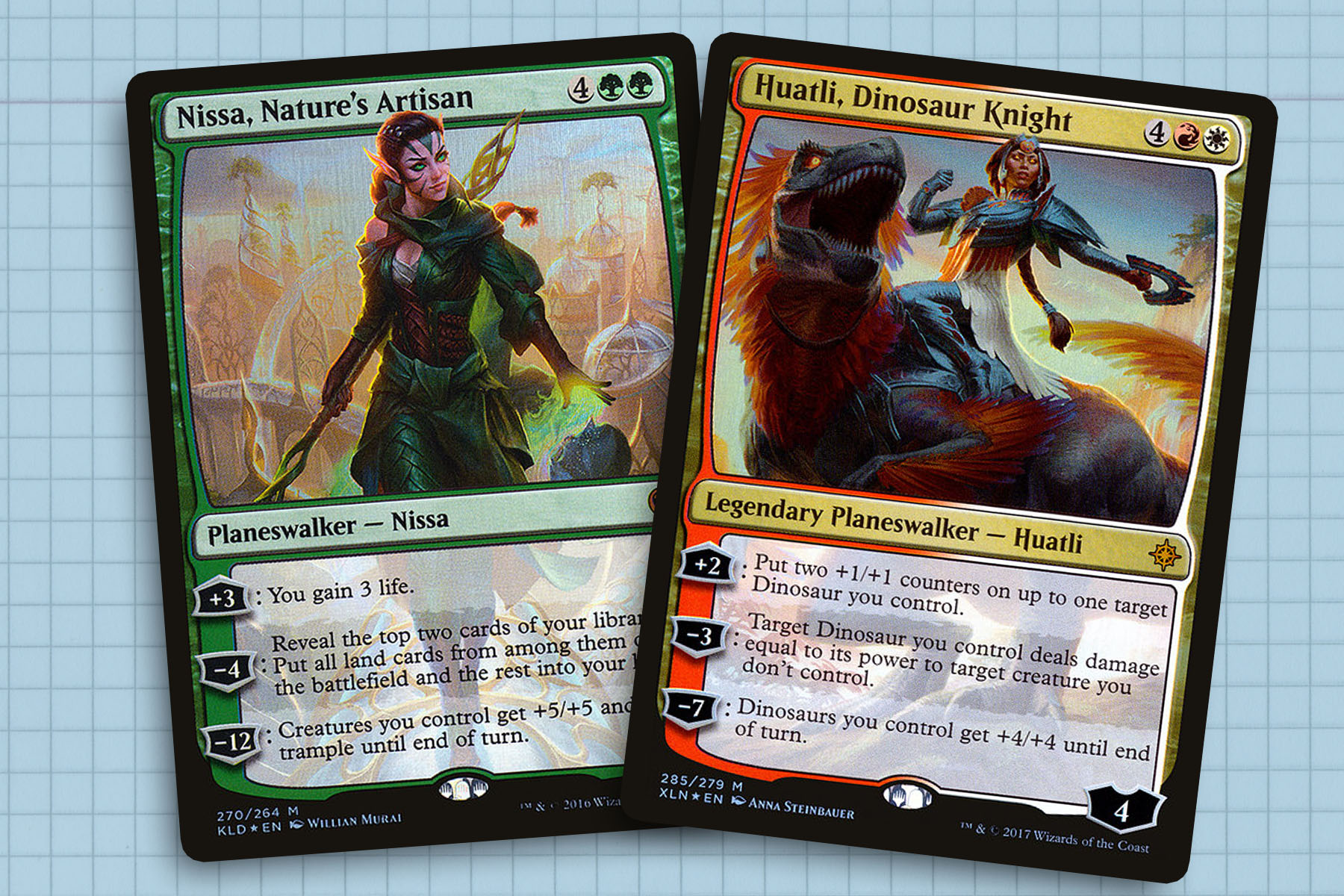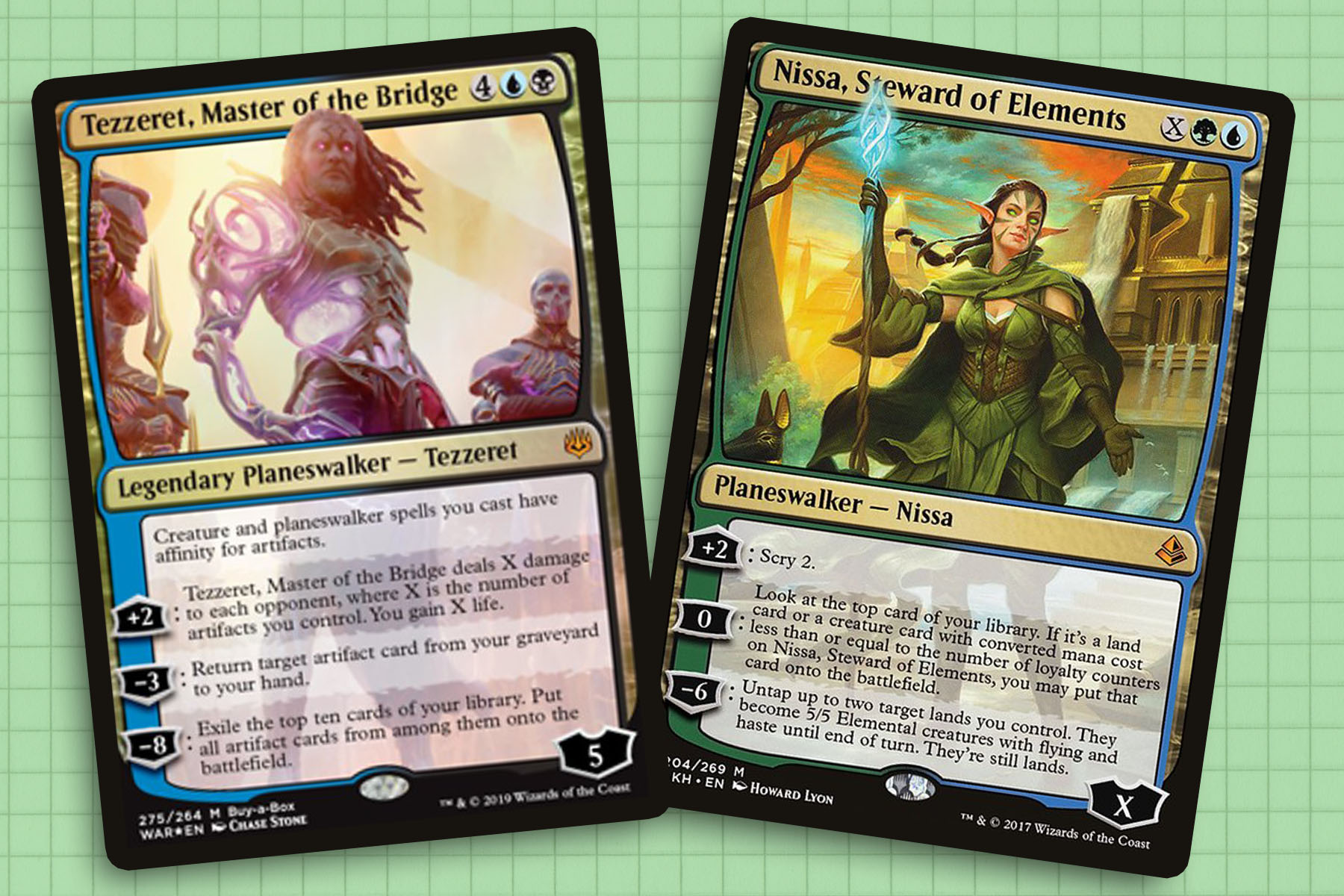Welcome back for part two of our journey through the history of planeswalker design. You can check out part one here. Today we pick up at an exciting moment in that history, when planeswalker bust out from the bounds of Standard legality.
My goal again today is to shed some light on the full landscape of planeswalker design, providing historical context and noting new developments. Hopefully this can be a prime resource for anyone looking to investigate the topic in the future.

Designing Outside of Standard
As it turned out, 2014 was an important year for the development of planeswalker design. In Conspiracy we were given Dack Fayden, the first the planeswalker who didn’t enter Magic through Standard. That Fall saw the release of Commander 2014, which gave us a cycle of mono-colored planeswalkers, some of which represented pre-Mending planeswalkers.
I wish that I had something more than just anecdotal evidence of the successes of Dack Fayden. Having never played him in the formats where he is the most powerful, all I can really say is that there is an inherent power to this card—it could not have passed through Standard without leaving carnage in its wake. I appreciate that they were willing to find an avenue to deliver more powerful new designs.
Then in Commander 2014 we were given Freyalise, Llanowar’s Fury, Nahiri, the Lithomancer, and Teferi, Temporal Archmage. Here Wizards took advantage of the rich history of the game to look into the past and represent pre-mending planeswalkers without showing off all of their god-like powers. The Commander design space once again allowed them to play with the power level of cards, providingthe perfect place to print another attempt at a viable red planeswalker, Daretti, Scrap Savant.
This period of design was a net positive in my eyes. It allowed for riskier designs to be made, with the understanding that the Constructed formats these cards were available in wouldn’t buckle under the pressure of their inclusion.

Seeing the Spark
The design of the Magic Origins Five represent what I believe to be a much more succinct version of the transformation of a planeswalker. Instead of the gruesome sickness depicted by Garruk Relentless, we see the legendary creatures becoming Planeswalkers for the first time on a single card. What I admire most out of these five cards is how they were able to tie the narrative points that caused each of these Planeswalkers to ignite into something that could be expressed through gameplay. These are magical moments and effective cards.
Later on, when Wizards revisited this design space with Nicol Bolas, the Ravager, the transformation felt much less dramatic. The machanic for transformation felt consistent with the old days of spark ignition—lots of mana can make you a planeswalker—but that does not feel as elegant as the Magic Origins Five.

Not Constructed Viable
With the release of Kaladesh in the Fall of 2016, Wizards introduced their new preconstructed theme decks meant to be used as a started product—planeswalker decks. This product facilitated the creation of planeswalker cards for each deck that were intentionally powered down, but still Standard legal. This change was rather subtle at the time, but showed Wizards’s willingness to push the number of planeswalkers occupying Standard.
Before Chandra, Pyrogenius and Nissa, Nature’s Artisan entered into Standard, there were 18 planeswalkers in the format. By the time they rotated out, with Kaladesh, there were 44. At first I saw this as devaluing the card type. But after seeing the success of War of the Spark, I can now see the value of a product that puts these characters into the hands of new players without being something that competitive players will need to buy.

Balancing for a Wider Scope
The last few years have seen a resurgence of planeswalker innovation and daring design. The idea of using X in a planeswalker mana cost had been something that Mark Rosewater admits purposely avoiding for years. That said, Nissa, Steward of Elements is a design I can respect that executes the idea of an X-mana planeswalker brilliantly. The scry ability allows you to set up for the second ability during a future activation, and the ultimate is a fair trade off for casting her for eight or more mana.
By creating non-legendary copies of himself, Jace, Cunning Castaway is the third card in Magic to circumvent the “legend rule,” behind Brothers Yamazaki and Mirror Gallery. Potential extra copies of your planeswalker meant that his first two abilities had to be contextually open-ended rather than game-breaking. Similarly, the intentional synergies between Will Kenrith and Rowan Kenrith took advantage of their printing outside of Standard-legal product to allow them abilities that worked alone, but benefited from being used in tandem to be very powerful as a pair.
Finally we reach present day, a Standard that currently houses 73 planeswalkers via the return of lower rarity walkers, including the first uncommon planeswalkers. To lessen the complexity of the card type, we finally get static and triggered abilities on planeswalkers across the set. Additionally, the decision for uncommon planeswalkers to only have negative loyalty abilities—harkening back to Sarkhan the Mad—was a wise decision, effectively making for attackable enchantments with a limited number of uses.
The most fascinating card in War of the Spark is the buy-a-box promo, Tezzeret, Master of the Bridge. He sports Affinity, a keyword not used in the set or anywhere in Standard. I will be interested to see if this testing of a single use of Affinity will lead to the return of other nostalgic mechanics in the future.
Conclusion
The creation of planeswalkers was a net positive for the game in my opinion. They helped to create a narrative through line for the Magic story, while also forcing the game to focus more on creatures than spells. Like any card type, we were bound to see their importance turned up to eleven for a spotlight set. War of the Spark is an excellent celebration.
Time will tell if there are any truly big mistakes made through this saturation of planeswalkers, but my hope is to see a minor reduction of their use in Standard-legal sets for the next few years regardless. Until next time, thanks for reading.
Ryan Sainio is a Graphic Designer who writes about EDH and the EDH community. He has been playing Magic: The Gathering since 7th Edition in 2002 and values flavorful and fun gameplay over competitively optimized decks.
Bibliography
- Rosewater, M. (2007, November 5). Planeswalk on the Wild Side, Part I. Retrieved from https://magic.wizards.com/en/articles/archive/making-magic/planeswalk-wild-side-part-i-2007-11-05
- Rosewater, M. (2007, November 12). Planeswalk on the Wild Side, Part II. Retrieved from https://magic.wizards.com/en/articles/archive/making-magic/planeswalk-wild-side-part-ii-2007-11-12
- Low, D. (2007, October 26). The Nineteen Principles for Developing Planeswalkers. Retrieved from https://magic.wizards.com/en/articles/archive/nineteen-principles-developing-planeswalkers-2007-10-26
- Rosewater, M. (n.d.). Drive to Work Episode 3: Planeswalkers [Audio blog post]. Retrieved from http://media.wizards.com/podcasts/magic/DrivetoWorkEp3Planeswalkers.m4a
- Beyer, D. (2008, October 29). Ajani: Faces of a Planeswalker. Retrieved from https://magic.wizards.com/en/articles/archive/savor-flavor/ajani-faces-planeswalker-2008-10-29
- LaPille, T. (2009, April 10). Building Bolas. Retrieved from https://magic.wizards.com/en/articles/archive/latest-developments/building-bolas-2009-04-09
- Erwin, E. (2010, March 5). PT San Diego Extra: Mike Turian Interview. Retrieved from https://www.youtube.com/watch?v=dNGVCZXU1Jo
- Rosewater, M. (2013, October 14). Drawing Attention. Retrieved from https://magic.wizards.com/en/articles/archive/making-magic/drawing-attention-2013-10-14
- LaPille, T. (2011, September 2). Garruk Flips Out. Retrieved from https://magic.wizards.com/en/articles/archive/latest-developments/garruk-flips-out-2011-09-02
- Rosewater, M. (2017, May 8). Amonkhet Talking, Part 3. Retrieved from https://magic.wizards.com/en/articles/archive/making-magic/amonkhet-talking-part-3-2017-05-08
- Rosewater, M. (2017, September 25). Dinosaurs and Vampires and Pirates (and Merfolk), Oh My, Part 1. Retrieved from https://magic.wizards.com/en/articles/archive/making-magic/dinosaurs-and-vampires-and-pirates-and-merfolk-oh-my-part-1-2017-09-25
- Rosewater, M. (2007, November 5). Planeswalk on the Wild Side, Part I. Retrieved from https://magic.wizards.com/en/articles/archive/making-magic/planeswalk-wild-side-part-i-2007-11-05
- Rosewater, M. (2007, November 12). Planeswalk on the Wild Side, Part II. Retrieved from https://magic.wizards.com/en/articles/archive/making-magic/planeswalk-wild-side-part-ii-2007-11-12
- Low, D. (2007, October 26). The Nineteen Principles for Developing Planeswalkers. Retrieved from https://magic.wizards.com/en/articles/archive/nineteen-principles-developing-planeswalkers-2007-10-26
- Rosewater, M. (n.d.). Drive to Work Episode 3: Planeswalkers [Audio blog post]. Retrieved from http://media.wizards.com/podcasts/magic/DrivetoWorkEp3Planeswalkers.m4a
- Beyer, D. (2008, October 29). Ajani: Faces of a Planeswalker. Retrieved from https://magic.wizards.com/en/articles/archive/savor-flavor/ajani-faces-planeswalker-2008-10-29
- LaPille, T. (2009, April 10). Building Bolas. Retrieved from https://magic.wizards.com/en/articles/archive/latest-developments/building-bolas-2009-04-09
- Erwin, E. (2010, March 5). PT San Diego Extra: Mike Turian Interview. Retrieved from https://www.youtube.com/watch?v=dNGVCZXU1Jo
- Rosewater, M. (2013, October 14). Drawing Attention. Retrieved from https://magic.wizards.com/en/articles/archive/making-magic/drawing-attention-2013-10-14
- LaPille, T. (2011, September 2). Garruk Flips Out. Retrieved from https://magic.wizards.com/en/articles/archive/latest-developments/garruk-flips-out-2011-09-02
- Rosewater, M. (2017, May 8). Amonkhet Talking, Part 3. Retrieved from https://magic.wizards.com/en/articles/archive/making-magic/amonkhet-talking-part-3-2017-05-08
- Rosewater, M. (2017, September 25). Dinosaurs and Vampires and Pirates (and Merfolk), Oh My, Part 1. Retrieved from https://magic.wizards.com/en/articles/archive/making-magic/dinosaurs-and-vampires-and-pirates-and-merfolk-oh-my-part-1-2017-09-25

